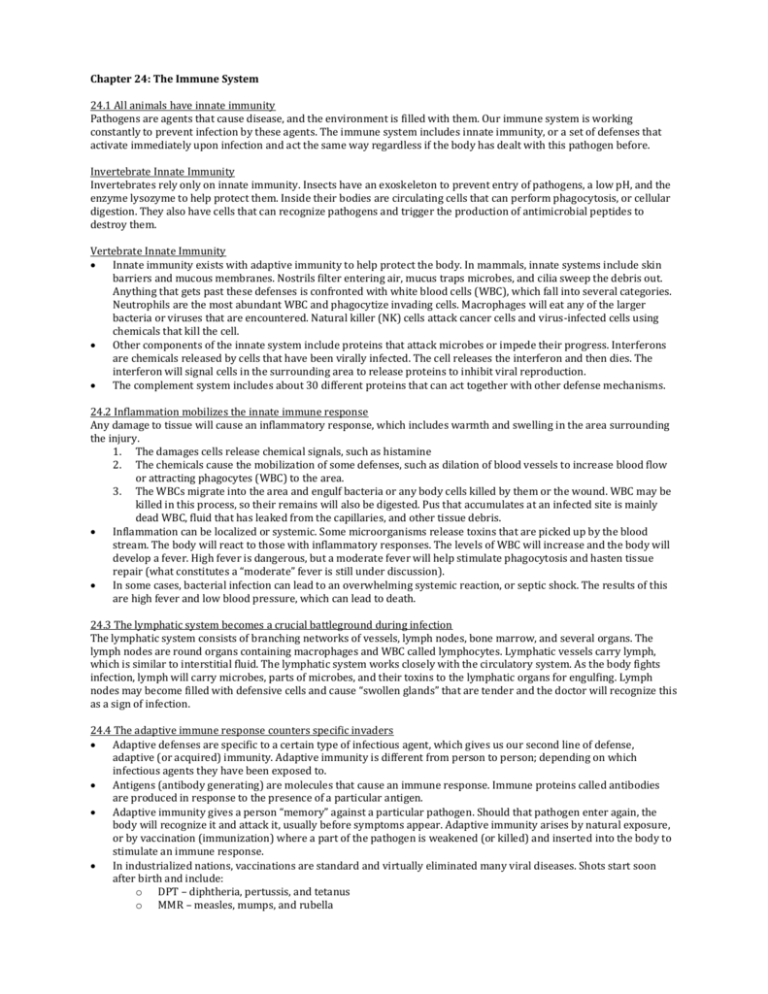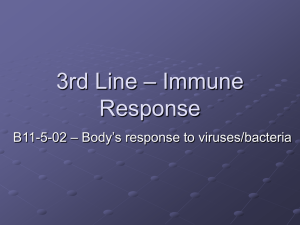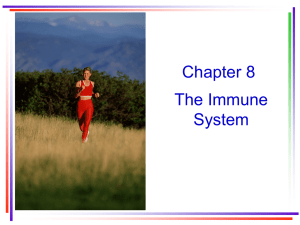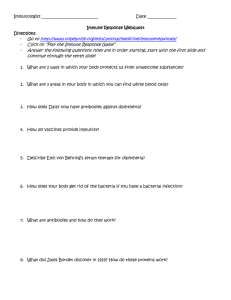Chapter 24: The Immune System 24.1 All animals have innate
advertisement

Chapter 24: The Immune System 24.1 All animals have innate immunity Pathogens are agents that cause disease, and the environment is filled with them. Our immune system is working constantly to prevent infection by these agents. The immune system includes innate immunity, or a set of defenses that activate immediately upon infection and act the same way regardless if the body has dealt with this pathogen before. Invertebrate Innate Immunity Invertebrates rely only on innate immunity. Insects have an exoskeleton to prevent entry of pathogens, a low pH, and the enzyme lysozyme to help protect them. Inside their bodies are circulating cells that can perform phagocytosis, or cellular digestion. They also have cells that can recognize pathogens and trigger the production of antimicrobial peptides to destroy them. Vertebrate Innate Immunity Innate immunity exists with adaptive immunity to help protect the body. In mammals, innate systems include skin barriers and mucous membranes. Nostrils filter entering air, mucus traps microbes, and cilia sweep the debris out. Anything that gets past these defenses is confronted with white blood cells (WBC), which fall into several categories. Neutrophils are the most abundant WBC and phagocytize invading cells. Macrophages will eat any of the larger bacteria or viruses that are encountered. Natural killer (NK) cells attack cancer cells and virus-infected cells using chemicals that kill the cell. Other components of the innate system include proteins that attack microbes or impede their progress. Interferons are chemicals released by cells that have been virally infected. The cell releases the interferon and then dies. The interferon will signal cells in the surrounding area to release proteins to inhibit viral reproduction. The complement system includes about 30 different proteins that can act together with other defense mechanisms. 24.2 Inflammation mobilizes the innate immune response Any damage to tissue will cause an inflammatory response, which includes warmth and swelling in the area surrounding the injury. 1. The damages cells release chemical signals, such as histamine 2. The chemicals cause the mobilization of some defenses, such as dilation of blood vessels to increase blood flow or attracting phagocytes (WBC) to the area. 3. The WBCs migrate into the area and engulf bacteria or any body cells killed by them or the wound. WBC may be killed in this process, so their remains will also be digested. Pus that accumulates at an infected site is mainly dead WBC, fluid that has leaked from the capillaries, and other tissue debris. Inflammation can be localized or systemic. Some microorganisms release toxins that are picked up by the blood stream. The body will react to those with inflammatory responses. The levels of WBC will increase and the body will develop a fever. High fever is dangerous, but a moderate fever will help stimulate phagocytosis and hasten tissue repair (what constitutes a “moderate” fever is still under discussion). In some cases, bacterial infection can lead to an overwhelming systemic reaction, or septic shock. The results of this are high fever and low blood pressure, which can lead to death. 24.3 The lymphatic system becomes a crucial battleground during infection The lymphatic system consists of branching networks of vessels, lymph nodes, bone marrow, and several organs. The lymph nodes are round organs containing macrophages and WBC called lymphocytes. Lymphatic vessels carry lymph, which is similar to interstitial fluid. The lymphatic system works closely with the circulatory system. As the body fights infection, lymph will carry microbes, parts of microbes, and their toxins to the lymphatic organs for engulfing. Lymph nodes may become filled with defensive cells and cause “swollen glands” that are tender and the doctor will recognize this as a sign of infection. 24.4 The adaptive immune response counters specific invaders Adaptive defenses are specific to a certain type of infectious agent, which gives us our second line of defense, adaptive (or acquired) immunity. Adaptive immunity is different from person to person; depending on which infectious agents they have been exposed to. Antigens (antibody generating) are molecules that cause an immune response. Immune proteins called antibodies are produced in response to the presence of a particular antigen. Adaptive immunity gives a person “memory” against a particular pathogen. Should that pathogen enter again, the body will recognize it and attack it, usually before symptoms appear. Adaptive immunity arises by natural exposure, or by vaccination (immunization) where a part of the pathogen is weakened (or killed) and inserted into the body to stimulate an immune response. In industrialized nations, vaccinations are standard and virtually eliminated many viral diseases. Shots start soon after birth and include: o DPT – diphtheria, pertussis, and tetanus o MMR – measles, mumps, and rubella o Polio o Chicken pox o Hepatitis Active Immunity occurs from antigens entering the body, either naturally or from vaccination. Passive immunity is passed from mother to child directly through the blood stream or through milk. 24.5 Lymphocytes mount a dual defense Lymphocytes are white blood cells that spend their time in the lymphatic system. They originate from stem cells in the bone marrow. Some will continue developing in the bone marrow; they are called B lymphocytes or B cells. Others will mature in the thymus and are called T lymphocytes or T cells. T cells will eventually go to the lymph nodes, spleen, or other lymphatic organs. Humoral immune response involves secretion of free-floating antibodies from the B cells. Humoral system defends against bacteria and viruses present in the body fluids (humors). The antibodies mark the invaders by binding to them and attracting phagocytic cells. Cell mediated immune response results from the action of defensive cells. Some T cells attack infected cells while others promote phagocytosis by white blood cells. 24.6 Antigens have specific regions where antibodies bind to them Most antigens are proteins or polysaccharides found on foreign cells. Others can be dissolved in body fluids, such as a toxin or venom. An antibody will bind to an exposed region of the antigen called the antigenic determinant or epitope. The determinant and antibody have complimentary regions that allow for this binding to occur. 24.7 Clonal selection musters defensive forces against specific antigens The immune system’s defense abilities depend on clonal selection. An antigen will activate only a small fraction of the lymphocytes. Once activated, these cells proliferate, forming clones – or genetically identical cells. This cloning allows the adaptive response to infection. Once selected, cells can differentiated into 2 types of genetically identical, but physically different cell types. o Effector cells are fast acting and can combat the antigen. If they are from B cells, then the effector cells make plasma cells. They will make enormous quantities of antibody very quickly. These cells have large amounts of endoplasmic reticulum for actively synthesizing and releasing antibody. The antibodies circulate and contribute to humoral immunity. They are highly effective, but short lived – lasting only 4-5 days. o Memory cells differ from effector cells in appearance and function. They remain in the lymph nodes to be activated in case of a second exposure to a pathogen. They can live decades, which is why childhood vaccinations are so effective. The production of memory cells is part of the secondary immune response, which is stronger and faster than the first (primary) immune response. 24.8 Antibodies are the weapons of the humoral immune response Each antibody is made up of 4 polypeptide chains: 2 “heavy” chains and 2 “light” chains. Each of the light chains is bonded to the heavy chain and give the molecule a distinct “Y” shape. An antibody has 2 functions: recognize and bind to a certain antigen to neutralize it. At the tip of each arm of the “Y” are antigen binding sites. This functions in recognition and binding. It is called a “V” region for variable, since there are many antigens. 24.9 Antibodies mark antigens for elimination Antibodies do NOT kill pathogens. They mark a pathogen and form and antibody-antigen complex. Once marked, the immune system can destroy the pathogen using several different methods. o Neutralization – block the ability of a bacteria or virus to infect the host cell and make them easily recognizable to macrophages. o Agglutination – clumping together of the pathogens to make them easier to catch by phagocytes. o Precipitation – antibody molecules link the dissolved antigens together and cause them to solidify in the surrounding liquids. This encourages engulfing. Activation of Complement System – several activated proteins form a complex that puts a hole in the plasma membrane of the invading cell, causing it to rupture. 24.10 Monoclonal antibodies are powerful tools in the lab or clinic Monoclonal means that all cells producing the antibodies are descended from a single cell, thus they are identical. These antibodies are harvested from cell cultures rather than living animals. Using this technique, the desired antibody can be determined and isolated from culture cells, and then it can be made in large amounts. Common use is the home pregnancy test that detects the hormone human chorionic gonadotropin (hCG). The antibody will bind to the hormone causing a reaction in the test. 24.11 Helper T cells stimulate the humoral and cell-mediated immune responses T cells only respond to antigens present on the body’s own cells. Cytotoxic T cells attack body cells that are infected with pathogen; helper T cells may activate cytotoxic T cells and macrophages or stimulate B cells to make antibodies. Helper T cells interact with other white blood cells to function as antigen presenting cells (APCs). These present foreign antigen cells to a helper T cells. Macrophages are typical APCs. The macrophage breaks the pathogen in to fragments of foreign antigen. It will bind the foreign antigen to special proteins called self proteins. Once bound, the helper T cells recognize the combination of self proteins and foreign antigens (non self). The T cell binds to a specific APC and foreign antigen complex and stimulate the immune response. 24.12 Cytotoxic T cells destroy infected body cells Cytotoxic T cells look for pathogens by looking for foreign antigens. They will also recognize the self-nonself complex and then bind to the infected cells. Once bound, it will synthesize toxic proteins that act on the bound cell. One protein is perforin, which can attach to the cell’s plasma membrane and put holes in it. The infected cell is destroyed, and the cytotoxic T cell can move on to others. 24.13 HIV destroys helper T cells, compromising body defenses AIDS results from infection by HIV. HIV depletes the helper T cells, causing the humoral and cell-mediated immunity to be impaired. HIV will bind to the surface of the T cell, enter it, and reproduce in it. Once copies release, the T cell is killed, and the virus infects other T cells. 24.14 Rapid evolution of HIV complicates AIDS treatment 24.15 The immune system depends on our molecular fingerprints The immune system can not only distinguish body cells from invading cells, it can also tell your cells from other people’s cells. There are genes at the multiple chromosomal loci for major histocompatibility complex molecules (MHC), which are the main self proteins. While these do protect from invasion, they can be a problem in organ transplantation. The recipient’s cells will not recognize a donor organ as “self” and may cause rejection. 24.16 Malfunction or failure of the immune system causes disease Autoimmune diseases occur when the immune system attacks the body’s own molecules. These diseases include Lupus, rheumatoid arthritis, Type 1 diabetes, and MS. Immunodeficiency disease occur when an immune response is deficient or absent. In some cases, people are born with it (SCID) or can acquire it (HIV). 24.17 Allergies are overreactions to certain environmental antigens Allergies are responses to otherwise harmless antigens in the surroundings. An antigen that causes allergies is termed an allergen. For an allergic reaction to occur, the following happens: o Allergen enters the blood stream and binds to effector B cells. o The B cells proliferate through clonal selection and make large quantities of antibody to it o Some of these cells attach to mast cells, which produce histamine and other chemicals of the inflammatory response. This histamine release causes the allergic symptoms. Antihistamines are medicines used to give temporary relief from the histamine symptoms.








